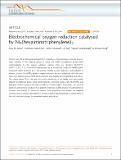Electrochemical oxygen reduction catalysed by Ni[SUBSCRIPT 3](hexaiminotriphenylene)[SUBSCRIPT 2]
Author(s)
Miner, Elise Marie; Fukushima, Tomohiro; Sheberla, Dennis; Sun, Lei; Surendranath, Yogesh; Dinca, Mircea; ... Show more Show less
DownloadMiner-2016-Electrochemical oxygen.pdf (606.7Kb)
OPEN_ACCESS_POLICY
Open Access Policy
Creative Commons Attribution-Noncommercial-Share Alike
Alternative title
Electrochemical oxygen reduction catalysed by Ni3(hexaiminotriphenylene)2
Terms of use
Metadata
Show full item recordAbstract
Control over the architectural and electronic properties of heterogeneous catalysts poses a major obstacle in the targeted design of active and stable non-platinum group metal electrocatalysts for the oxygen reduction reaction. Here we introduce Ni[SUBSCRIPT 3](HITP)[SUBSCRIPT 2] (HITP=2, 3, 6, 7, 10, 11-hexaiminotriphenylene) as an intrinsically conductive metal-organic framework which functions as a well-defined, tunable oxygen reduction electrocatalyst in alkaline solution. Ni[SUBSCRIPT 3](HITP)[SUBSCRIPT 2] exhibits oxygen reduction activity competitive with the most active non-platinum group metal electrocatalysts and stability during extended polarization. The square planar Ni-N[SUBSCRIPT 4] sites are structurally reminiscent of the highly active and widely studied non-platinum group metal electrocatalysts containing M-N[SUBSCRIPT 4] units. Ni[SUBSCRIPT 3](HITP)[SUBSCRIPT 2] and analogues thereof combine the high crystallinity of metal-organic frameworks, the physical durability and electrical conductivity of graphitic materials, and the diverse yet well-controlled synthetic accessibility of molecular species. Such properties may enable the targeted synthesis and systematic optimization of oxygen reduction electrocatalysts as components of fuel cells and electrolysers for renewable energy applications.
Date issued
2016-03Department
Massachusetts Institute of Technology. Department of Chemistry; Massachusetts Institute of Technology. Research Laboratory of ElectronicsJournal
Nature Communications
Publisher
Nature Publishing Group
Citation
Miner, Elise M., Tomohiro Fukushima, Dennis Sheberla, Lei Sun, Yogesh Surendranath, and Mircea Dincă. “Electrochemical Oxygen Reduction Catalysed by Ni3(hexaiminotriphenylene)2.” Nat Comms 7 (March 8, 2016): 10942. © 2017 Macmillan Publishers Limited
Version: Final published version
ISSN
2041-1723